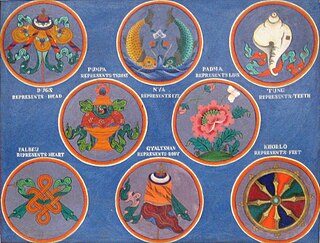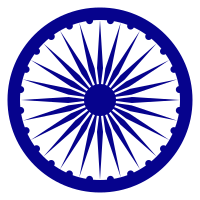Symbolic history
When Gautama Buddha achieved enlightenment at Bodh Gaya, he came to Sarnath. There, he found his five disciples, Assaji, Mahānāman, Kondañña, Bhaddiya and Vappa, who had earlier abandoned him. He introduced his first teachings to them, thereby establishing the Dharmachakra;. This is the motif taken up by Ashoka and portrayed on top of his pillars.
The 24 spokes represent the twelve causal links taught by the Buddha and paṭiccasamuppāda (Dependent Origination, Conditional Arising) in forward and then reverse order. [2] The first 12 spokes represent 12 stages of suffering. The next 12 spokes represent no cause no effect. So, due to awareness of the mind, the formation of mental conditioning stops. This process stops the process of birth and death, i.e. nibbāna. It also depicts the “wheel of time”. The twelve causal links, paired with their corresponding symbols, are:
- Avidyā ignorance
- Saṅkhāra conditioning of mind unknowingly
- Vijñāna not being conscious
- Nāmarūpa name and form (constituent elements of mental and physical existence)
- Ṣalāyatana six senses (eye, ear, nose, tongue, body, and mind)
- Sparśa contact
- Vedanā sensation
- Taṇhā thirst
- Upādāna grasping [3]
- Bhava coming to be
- Jāti birth
- Jarāmaraṇa old age [4] and death [5] – corpse being carried.
These 12 in forward and reverse represent a total 24 spokes representing the dharma. The Ashoka Chakra depicts the 24 principles that should be present in a human.

The bhavacakra or wheel of life is a visual teaching aid, symbolically representing saṃsāra. It is found on the outside walls of Tibetan Buddhist temples and monasteries in the Indo-Tibetan region, to help non Buddhists understand Buddhist teachings. It is used in Indian Buddhism and Tibetan Buddhism.

The State Emblem of India is the national emblem of the Republic of India and is used by the union government, many state governments, and other government agencies. The emblem is an adaptation of the Lion Capital of Ashoka, an ancient sculpture dating back to 280 BCE during the Maurya Empire. The statue is a three dimensional emblem showing four lions. It became the emblem of the Dominion of India in December 1947, and later the emblem of the Republic of India. The State Emblem of India is an official seal of the Government of India. It is used as the national emblem of India and appears on official documents, currency and passports.

Buddhist symbolism is the use of symbols to represent certain aspects of the Buddha's Dharma (teaching). Early Buddhist symbols which remain important today include the Dharma wheel, the Indian lotus, the three jewels and the Bodhi tree.

The national flag of India, colloquially called Tiraṅgā, is a horizontal rectangular tricolour flag, the colours being of India saffron, white and India green; with the Ashoka Chakra, a 24-spoke wheel, in navy blue at its centre. It was adopted in its present form during a meeting of the Constituent Assembly held on 22 July 1947, and it became the official flag of the Union of India on 15 August 1947. The flag was subsequently retained as that of the Republic of India. In India, the term "tricolour" almost always refers to the Indian national flag.

The Triratna is a Buddhist symbol, thought to visually represent the Three Jewels of Buddhism.

The Ashtamangala is a sacred suite of Eight Auspicious Signs featured in a number of Indian religions such as Hinduism, Jainism, and Buddhism. The symbols or "symbolic attributes" are yidam and teaching tools. Not only do these attributes point to qualities of enlightened mindstream, but they are the investiture that ornaments these enlightened "qualities". Many cultural enumerations and variations of the Ashtamangala are extant.
The Free Software Foundation of India (FSFI) is the Indian sister organisation to the US-based Free Software Foundation. It was founded in Thiruvananthapuram (Trivandrum) in 2001 as a non-profit Company. The FSFI advocates to promote the use and development of free software in India. This includes educating people about free software, including how it can help the economy of a developing country like India. FSF India regards non-free software as not a solution, but a problem to be solved. Free software is sometimes locally called swatantra software in India.

The dharmachakra or wheel of dharma is a widespread symbol used in Buddhism. The symbol also finds usage in Hinduism, particularly in places that underwent religious transformation, and in Jainism and in modern India.
Jarāmaraṇa is Sanskrit and Pāli for "old age" and "death". In Buddhism, jaramarana is associated with the inevitable decay and death-related suffering of all beings prior to their rebirth within saṃsāra.
Sacca is a Pali word meaning "real" or "true". In early Buddhist literature, sacca is often found in the context of the "Four Noble Truths", a crystallization of Buddhist wisdom. In addition, sacca is one of the ten pāramīs or "most high" a bodhisatta must develop in order to become a Buddha.
Nekkhamma is a Pāli word generally translated as "renunciation" or "the pleasure of renunciation" while also conveying more specifically "giving up the world and leading a holy life" or "freedom from lust, craving and desires." In Buddhism's Noble Eightfold Path, nekkhamma is the first practice associated with "Right Intention." In the Theravada list of ten perfections, nekkhamma is the third practice of "perfection." It involves non-attachment (detachment).
Indriya is the Sanskrit and Pali term for physical strength or ability in general, and for the senses more specifically. The term literally means "belonging to Indra," chief deity in the Rig Veda and lord of the Trāyastriṃśa heaven hence connoting supremacy, dominance and control, attested in the general meaning of "power, strength" from the Rig Veda.

Abhijñā is a Buddhist term generally translated as "direct knowledge", "higher knowledge" or "supernormal knowledge." In Buddhism, such special knowledge is obtained through virtuous living and meditation. The attainment of the four jhanas, or meditative absorptions, is considered a prerequisite for their attainment. In terms of specifically enumerated knowledges, these include mundane extra-sensory abilities as well as the supramundane, meaning the extinction of all mental intoxicants (āsava).

The Simsapa tree is mentioned in ancient Buddhist discourses traditionally believed to have been delivered 2,500 years ago. The tree has been identified as either Dalbergia sissoo, a rosewood tree common to India and southeast Asia, or Amherstia nobilis, another South Asian tree, of the family Caesalpiniaceae.

Sarnath Museum is the oldest site museum of the Archaeological Survey of India. It houses the findings and excavations at the archaeological site of Sarnath, by the Archaeological Survey of India. Sarnath is located near Varanasi, in the state of Uttar Pradesh. The museum has 6,832 sculptures and artefacts.

Shanti Stupa is a Buddhist white-domed Stupa (chorten) on a hilltop in Chanspa, Leh district, Ladakh, in north India. It was built in 1991 by Japanese Buddhist Bhikshu, Gyomyo Nakamura. The Shanti Stupa holds the relics of the Buddha at its base, enshrined by the 14th Dalai Lama. The Stupa has become a tourist attraction not only due to its religious significance but also due to its location which provides panoramic views of the surrounding landscape.

The Lion Capital of Ashoka is the capital, or head, of a column erected by the Mauryan emperor Ashoka in Sarnath, India, c. 250 BCE. Its crowning features are four life-sized lions set back to back on a drum-shaped abacus. The side of the abacus is adorned with wheels in relief, and interspersing them, four animals, a lion, an elephant, a bull, and a galloping horse follow each other from right to left. A bell-shaped lotus forms the lowest member of the capital, and the whole 2.1 metres (7 ft) tall, carved out of a single block of sandstone and highly polished, was secured to its monolithic column by a metal dowel. Erected after Ashoka's conversion to Buddhism, it commemorated the site of Gautama Buddha's first sermon some two centuries before.
Buddhavanam is a tourism project in Nagarjuna Sagar, Telangana created by the Telangana State Tourism Development Corporation. The project was sanctioned by the Government of India viz., Integrated Development of Nagarjunasagar as part of Lower Krishna valley Buddhist circuit with a view to attract large number of domestic and foreign tourists particularly from the South-East Asian countries.
Badruddin Faiz Tyabji (1907-1995) was a senior Indian Civil Service officer, who served as Vice-Chancellor of the Aligarh Muslim University, from 1962 to 1965. While serving as a diplomat in 1948, he had undertaken the task of starting the Embassy of India, Brussels. He also served as Indian ambassador in Jakarta, Tehran, Bonn and Tokyo.

The Buddha Preaching his First Sermon is a stone sculpture of the 5th-century CE showing Gautama Buddha in the "teaching posture" or dharmachakra pravartana mudrā. The relief is 5' 3" tall, and was excavated at Sarnath, India by F. O. Oertel during the 1904–1905 excavation season of the Archaeological Survey of India (ASI); it was found in an area to the south of the Dhamek Stupa.















